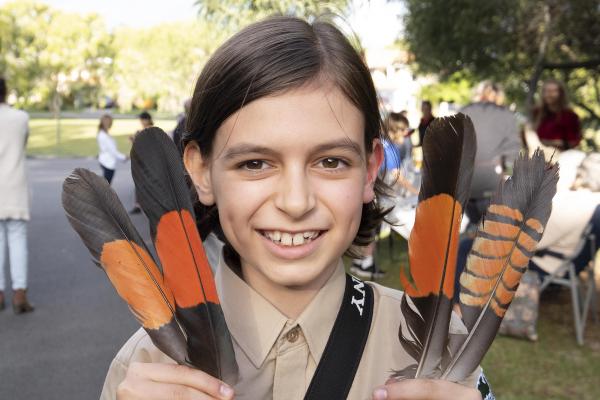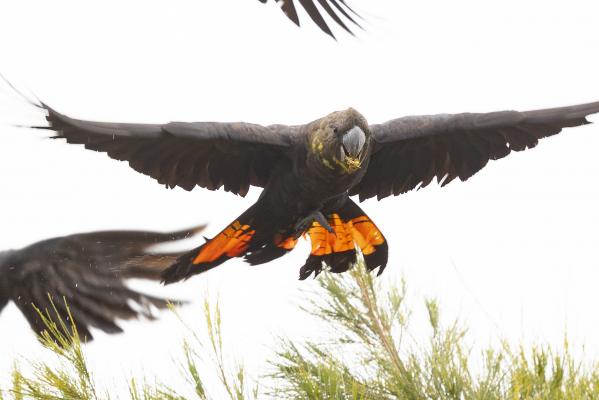Noosa Council has agreed to discuss a land swap with the Uniting Church to protect Glossy Black Cockatoo habitat at Sunrise Beach.
But the deal rests in the hands of the Church which already has a contract with Lendlease to develop its aged care facility and retirement homes.
Last Sunday about a dozen Glossy Black Cockatoos descended on feed trees surrounding the Sunrise Beach Uniting Church, just as the congregation was leaving the morning service, as if to tell them this was also their special place.
The glossies most ardent supporters, Glossy Team Sunrise led by 10-year-old Spencer Hitchen and his mother Maxine were there to marvel at them, saying more than 30 of the vulnerable species had recently been seen on the site the church plans to clear to develop a 102-bed residential aged care home and a retirement village.
Having now secured more than 43,000 signatures on a petition to support the retention of the habitat Spencer and Maxine last Thursday attended Noosa Council’s Ordinary Meeting to stand up for the rights of the glossies, voice their concerns at the efficacy of a proposed “offset site” and request Council consider a land swap with the Uniting Church between the proposed development site and a suitable Council-owned site.
Mayor Clare Stewart responded to their questions saying “yes council would be willing to enter into a discussion with Uniting Church Australia about a land swap if the church wishes to discuss such a proposal with council, however it is council’s understanding that the Church have a contract with Lendlease to develop the individual retirement homes and intend to develop the aged care facility with works to commence upgrading the intersection shortly”.
Cr Stewart said there was limited land owned by Council that may be suitable for the development and free of environmental constraints.
She said however that rehabilitation of degraded bushland as an offset site required as part of the development approval conditions was expected to lead to positive outcomes for native fauna in the area and included the provision of glossy feed trees in a ratio of eight to every one cleared. She said while the science on the preference by glossy blacks for one tree over another was unclear it was seen as a positive step in providing food trees in the area.
Maxine said the proposed offset site which had been planted with glossy feed trees, Casuarina and Allocasuarina, known commonly as she-oaks only 18 months ago could not possibly replicate their habitat as the cockatoos only feed from a select few female mature trees after they have reached 8-10 years of growth.
Sunrise Uniting Church congregation members are convinced the offset site will compensate for the habitat loss.
“There’s always habitat loss for every development. As long as there’s an offset,” one member said. “We need the nursing home. There has to be a balance.”
However Maxine said the group feared for the survival of the birds if the habitat is lost and believes it could lead to a regional extinction.
A study conducted on the development site on the Glossy Black-cockatoo feed tree selection by University of Sunshine Coast Honours student Helen North found the species was particularly at risk due to the limited number of Casuarina and Allocasuarina species on which they feed, which is compounded by their propensity for selecting only specific individual feed trees within patches.
In surveying the site trees Ms North concluded that the larger trees were “preferentially foraged, with nutritional profitability as the primary factor governing tree selection”. “Feed tree cones had higher seed number and seed mass, with seeds containing higher levels of fatty acids and nutrients than non-feed tree cones,” she concluded.
Under the recently released Queensland Environmental Offset Policy for a land-based offset in relation to a threatened animal, such as the Glossy Black Cockatoo, “under the Nature Conservation Act 1992 – the offset site must contain, or be capable of containing, a self-sustaining population of that same impacted species”.
Last Friday Glossy Team Sunrise held a Glossy Strike as thousands of school children across the nation staged their own School Strike for Climate.
Local residents including school children attended to voice their concerns about the proposed habitat loss and support its retention.
One resident said it didn’t make sense for developers to totally clear a site and then landscape it once construction was completed. “Why don’t they work with the environment that’s here,” she said.
Noosa councillor Amelia Lorentson attended the protest meeting to show her support, saying what Spencer was doing was very important.
“What the community is telling us is the environment has rights and we should be defending them,” she said.
“What I’m going to take back to Council is we have to make sure this doesn’t happen again.”
USC geographer and local resident Javier Leon also attended, urging people to support the call to save the habitat.
“People are not doing this, that’s the problem. We need to fight to the end,” he said.
The Uniting Church did not reply when asked if it would consider discussing a land swap with Noosa Council but issued a statement saying: “although UnitingCare supports everyone’s right to peaceful protest, we believe it is necessary to address misinformation and disinformation circulating about the proposed residential aged care home at Sunrise Beach“.
The statement continues to say:
“There is no evidence to substantiate the claim that the site is “critical habitat” for the Glossy BlackCockatoo.
-The site is an area which was historically cleared of vegetation and the she-oaks have established as pioneer species in dense plantings, i.e. regrowth. This is not dissimilar to other areas in the immediate locality.
– As per the (Ecological Management Plan) EMP, a total of 58 she-oak trees will be cleared for the development. Importantly, not all of which are active feed trees for the Glossy Black Cockatoo.
– Active feed trees occur in the immediate locality beyond the site.
-; There is no basis to suggest the rehabilitation site will be unsuccessful. The she-oak is a fast- growing tree species which will readily establish (as it has done on the development site) on the rehabilitation site (and is already growing in the surrounds). The rehabilitation site will provide nesting, foraging and watering resources for the glossy black cockatoo and other threatened fauna.
– Active feed trees have been identified within the rehabilitation site. More than 100 potted she- oaks (from the site) are to be planted in the near future at the rehabilitation site, while hundreds more are planned for future planting.
– The rehabilitation site includes large gums which are potential nesting habitat for the glossy black cockatoo. Nesting habitat is considered a limiting factor for this species. Nest boxes are to be installed in the large trees at the rehabilitation site.
– A permanent water source will be investigated for the rehabilitation site.
There is strong demand for housing designed to cater for Noosa’s growing ageing population and UnitingCare’s Blue Care aged care home at Sunrise Beach will compassionately care for and support ageing members of the Sunshine Coast community long into the future.“








